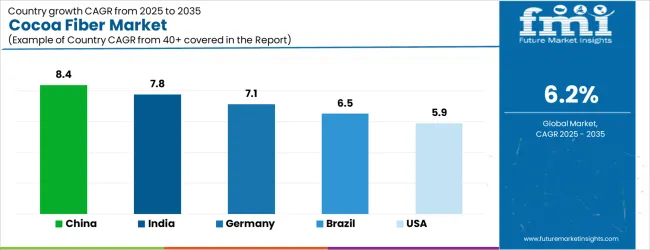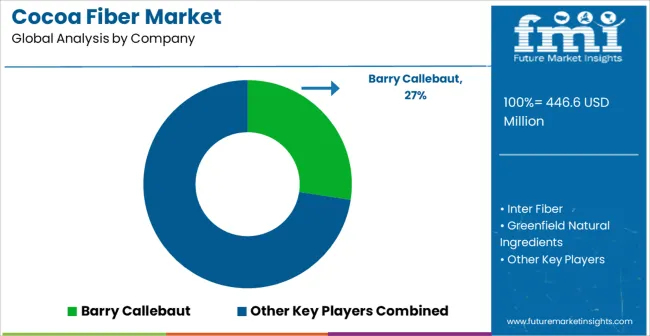The Cocoa Fiber Market is estimated to be valued at USD 446.6 million in 2025 and is projected to reach USD 815.0 million by 2035, registering a compound annual growth rate (CAGR) of 6.2% over the forecast period.

| Metric | Value |
|---|---|
| Cocoa Fiber Market Estimated Value in (2025 E) | USD 446.6 million |
| Cocoa Fiber Market Forecast Value in (2035 F) | USD 815.0 million |
| Forecast CAGR (2025 to 2035) | 6.2% |
The Cocoa Fiber market is witnessing steady growth driven by the rising demand for functional and dietary fiber ingredients in the food and beverage sector. The future outlook for this market is shaped by the increasing focus on health-conscious consumption patterns and the growing awareness of dietary fibers' role in digestive health. Rising preference for clean-label and natural ingredients has further fueled the adoption of cocoa fiber in various food formulations.
Additionally, innovations in processing technologies have enhanced the functional properties of cocoa fiber, including its solubility, taste profile, and incorporation flexibility in different applications. The market is supported by the expanding confectionery, bakery, and nutraceutical industries that seek to enhance product quality while offering health benefits.
Furthermore, the shift towards plant-based and sustainable food solutions has opened avenues for cocoa fiber as a valuable ingredient As consumers increasingly prioritize nutritional content alongside taste, cocoa fiber is expected to maintain a strong growth trajectory, with opportunities across developed and emerging markets.
The cocoa fiber market is segmented by product type, application, and geographic regions. By product type, cocoa fiber market is divided into Conventional and Organic. In terms of application, cocoa fiber market is classified into Confectionery, Functional Food, Bakery Items, Beverages, Cosmetics, Pharmaceuticals, and Packaging Industry. Regionally, the cocoa fiber industry is classified into North America, Latin America, Western Europe, Eastern Europe, Balkan & Baltic Countries, Russia & Belarus, Central Asia, East Asia, South Asia & Pacific, and the Middle East & Africa.

The conventional product type segment is projected to hold 60.0% of the Cocoa Fiber market revenue share in 2025, establishing it as the leading product type. This segment has been driven by the widespread availability and established processing methods that allow consistent quality and functionality. Conventional cocoa fiber provides the necessary dietary fiber benefits while maintaining compatibility with various food formulations.
The segment has benefited from growing consumer demand for natural and minimally processed ingredients, which reinforces its adoption across different food products. Additionally, conventional cocoa fiber offers cost-effectiveness and scalability, making it an attractive option for food manufacturers aiming to enhance nutritional profiles without compromising taste or texture.
Continuous investment in production infrastructure and the development of versatile cocoa fiber applications further support the dominance of this segment The segment’s growth is also reinforced by the demand from both domestic and international markets seeking reliable and health-oriented ingredients.

The confectionery application segment is expected to capture 25.0% of the Cocoa Fiber market revenue share in 2025, positioning it as a leading application. Growth in this segment has been influenced by the rising incorporation of dietary fibers in chocolate, candies, and other confectionery products to meet consumer demand for healthier options.
Cocoa fiber enhances the texture, mouthfeel, and nutritional content of confectionery items while allowing manufacturers to differentiate products in a competitive market. Additionally, the integration of cocoa fiber in confectionery has been supported by advancements in processing techniques that maintain flavor integrity and product stability.
Increased focus on clean-label and functional foods has further accelerated adoption in this segment The segment’s prominence is reinforced by the continued growth of the global confectionery industry and the trend of combining indulgence with health benefits, positioning cocoa fiber as a key ingredient in future product innovations.
A dietary fiber known as cocoa fiber; is added to food as an addition. Dietary fiber provides a wide range of beneficial health effects, including the prevention of colon cancer, heart disease, and diabetes, the treatment of colon disorders, the improvement of gastrointestinal function, and many more. By micronization, washing, and thermal steam, cocoa fibers are produced from roasted cocoa shells. Additionally, it is a cocoa fiber that has a wide range of applications in the food and beverage, cosmetics, pharmaceutical, and bread industries.
When used in place of cocoa powder, cocoa fiber increases nutritional content, shelf life, texture, and flavor in a negligible way. Cocoa fibers are also utilized in the production of cardboard and paper to develop specialized solutions for various sectors. To address the evolving needs of consumers with respect to a range of health concerns and the rising demand for healthy and cutting-edge products, manufacturers are introducing cocoa-based fiber versions.
In our new study, ESOMAR-certified market research and consulting firm Future Market Insights (FMI) offers insights into key factors driving demand for Cocoa Fiber.

| Country | CAGR |
|---|---|
| China | 8.4% |
| India | 7.8% |
| Germany | 7.1% |
| Brazil | 6.5% |
| USA | 5.9% |
| UK | 5.3% |
| Japan | 4.7% |
The Cocoa Fiber Market is expected to register a CAGR of 6.2% during the forecast period, exhibiting varied country level momentum. China leads with the highest CAGR of 8.4%, followed by India at 7.8%. Developed markets such as Germany, France, and the UK continue to expand steadily, while the USA is likely to grow at consistent rates. Japan posts the lowest CAGR at 4.7%, yet still underscores a broadly positive trajectory for the global Cocoa Fiber Market. In 2024, Germany held a dominant revenue in the Western Europe market and is expected to grow with a CAGR of 7.1%. The USA Cocoa Fiber Market is estimated to be valued at USD 157.8 million in 2025 and is anticipated to reach a valuation of USD 157.8 million by 2035. Sales are projected to rise at a CAGR of 0.0% over the forecast period between 2025 and 2035. While Japan and South Korea markets are estimated to be valued at USD 23.1 million and USD 15.6 million respectively in 2025.

| Item | Value |
|---|---|
| Quantitative Units | USD 446.6 Million |
| Product Type | Conventional and Organic |
| Application | Confectionery, Functional Food, Bakery Items, Beverages, Cosmetics, Pharmaceuticals, and Packaging Industry |
| Regions Covered | North America, Europe, Asia-Pacific, Latin America, Middle East & Africa |
| Country Covered | United States, Canada, Germany, France, United Kingdom, China, Japan, India, Brazil, South Africa |
| Key Companies Profiled | Barry Callebaut, Inter Fiber, Greenfield Natural Ingredients, Cargill Inc., Jindal Cocoa, Carlyle Cocoa, Archer Daniels Midland Company, United Cocoa Processor, and Cemoi |
The global cocoa fiber market is estimated to be valued at USD 446.6 million in 2025.
The market size for the cocoa fiber market is projected to reach USD 815.0 million by 2035.
The cocoa fiber market is expected to grow at a 6.2% CAGR between 2025 and 2035.
The key product types in cocoa fiber market are conventional and organic.
In terms of application, confectionery segment to command 25.0% share in the cocoa fiber market in 2025.






Our Research Products

The "Full Research Suite" delivers actionable market intel, deep dives on markets or technologies, so clients act faster, cut risk, and unlock growth.

The Leaderboard benchmarks and ranks top vendors, classifying them as Established Leaders, Leading Challengers, or Disruptors & Challengers.

Locates where complements amplify value and substitutes erode it, forecasting net impact by horizon

We deliver granular, decision-grade intel: market sizing, 5-year forecasts, pricing, adoption, usage, revenue, and operational KPIs—plus competitor tracking, regulation, and value chains—across 60 countries broadly.

Spot the shifts before they hit your P&L. We track inflection points, adoption curves, pricing moves, and ecosystem plays to show where demand is heading, why it is changing, and what to do next across high-growth markets and disruptive tech

Real-time reads of user behavior. We track shifting priorities, perceptions of today’s and next-gen services, and provider experience, then pace how fast tech moves from trial to adoption, blending buyer, consumer, and channel inputs with social signals (#WhySwitch, #UX).

Partner with our analyst team to build a custom report designed around your business priorities. From analysing market trends to assessing competitors or crafting bespoke datasets, we tailor insights to your needs.
Supplier Intelligence
Discovery & Profiling
Capacity & Footprint
Performance & Risk
Compliance & Governance
Commercial Readiness
Who Supplies Whom
Scorecards & Shortlists
Playbooks & Docs
Category Intelligence
Definition & Scope
Demand & Use Cases
Cost Drivers
Market Structure
Supply Chain Map
Trade & Policy
Operating Norms
Deliverables
Buyer Intelligence
Account Basics
Spend & Scope
Procurement Model
Vendor Requirements
Terms & Policies
Entry Strategy
Pain Points & Triggers
Outputs
Pricing Analysis
Benchmarks
Trends
Should-Cost
Indexation
Landed Cost
Commercial Terms
Deliverables
Brand Analysis
Positioning & Value Prop
Share & Presence
Customer Evidence
Go-to-Market
Digital & Reputation
Compliance & Trust
KPIs & Gaps
Outputs
Full Research Suite comprises of:
Market outlook & trends analysis
Interviews & case studies
Strategic recommendations
Vendor profiles & capabilities analysis
5-year forecasts
8 regions and 60+ country-level data splits
Market segment data splits
12 months of continuous data updates
DELIVERED AS:
PDF EXCEL ONLINE
Cocoa Shell Fiber Market Analysis - Size, Share & Forecast 2025 to 2035
Fiber Optic Probe Hydrophone (FOPH) Market Size and Share Forecast Outlook 2025 to 2035
Fiberglass Centrifugal Fan Market Size and Share Forecast Outlook 2025 to 2035
Fiber to the Home Market Size and Share Forecast Outlook 2025 to 2035
Fiber Based Packaging Market Size and Share Forecast Outlook 2025 to 2035
Fiber Lid Market Forecast and Outlook 2025 to 2035
Fiberglass Tanks Market Size and Share Forecast Outlook 2025 to 2035
Fiber Sorter Market Size and Share Forecast Outlook 2025 to 2035
Fiber Reinforced Polymer Panel and Sheet Market Size and Share Forecast Outlook 2025 to 2035
Fiber Optic Tester Market Size and Share Forecast Outlook 2025 to 2035
Fiber Laser Market Size and Share Forecast Outlook 2025 to 2035
Fiberglass Market Size and Share Forecast Outlook 2025 to 2035
Cocoa Bean Derivatives Market Size and Share Forecast Outlook 2025 to 2035
Fiber Spinning Equipment Market Size and Share Forecast Outlook 2025 to 2035
Fiber Reinforced Plastic (FRP) Panels & Sheets Market Size and Share Forecast Outlook 2025 to 2035
Fiberglass Fabric Market Size and Share Forecast Outlook 2025 to 2035
Fiber Optic Connectivity Market Size and Share Forecast Outlook 2025 to 2035
Fiber Optic Collimating Lens Market Size and Share Forecast Outlook 2025 to 2035
Cocoa-Derived Peptides For Skin Repair Market Size and Share Forecast Outlook 2025 to 2035
Fiberglass Duct Wrap Insulation Market Size and Share Forecast Outlook 2025 to 2035

Thank you!
You will receive an email from our Business Development Manager. Please be sure to check your SPAM/JUNK folder too.
Chat With
MaRIA